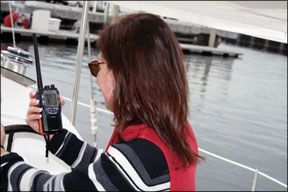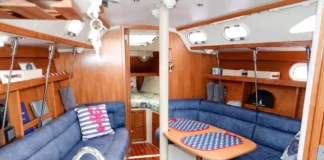While it sometimes seems marine electronics marketers are piling on unnecessary features just because they can, anyone who has watched their $300 cell phone disappear over the rail or has missed a call from the boss while they were playing hooky on the water can appreciate Cobras newest handheld marine VHF.

The MR HH475 FLT BT is a full-feature, floating handheld VHF that can also link up to any Bluetooth-enabled cell phone. The radio uses a tiny wireless Bluetooth transceiver (the same technology used to link cell phones to wireless ear buds) to synchronize with your cell phone. When you go for a sail, you can put your cell phone belowdecks and use your VHF to monitor and receive any incoming phone calls. You cannot use the VHF keypad to dial any number, but you can use it to re-dial the previous number stored in your phones call log, or, on some phones, use the voice-activated calling feature to call numbers stored in your phones address book. One key drawback: You cannot monitor VHF calls while youre actually having a phone conversation on the radio, using the Bluetooth feature.
The MR HH475 FLT BT was introduced in late 2009, on the heels of Practical Sailors multi-part review of handheld VHFs. Heres a quick recap of findings from those reports: Among the expensive, full-featured handheld VHFs ($140 or more), the Standard Horizon 850S earned the Best Choice, the Icom M36 and Standard Horizon HX600S were Recommended, and the Standard Horizon HX750S was rated a Budget Buy. Among the budget handheld VHFs (about $100), the Best Choice Standard Horizon HX280S edged past the Cobra HH325 VP, a Recommended product. Detailed results from those tests can be found in the April 2009 (budget handheld VHFs), July 2009 (expensive handheld VHFs), and December 2009 (handheld VHF update) issues of Practical Sailor.
HOW WE TESTED
The Cobra HH475s antenna is permanently fixed to the unit, which prevented testers from putting the VHF through the usual series of tests using the Ramsey COM3010 communications service monitor. Noting that other units in the Cobra family, like the HH325 and HH425, have performed within industry standards in previous bench tests, testers opted for a field comparison.
The field test matched the HH475 ($180) against two models Practical Sailor had previously tested on the bench. A tester ashore used the HH475, the Cobra HH325 ($100), and the Standard Horizon HX280S ($100) to try to contact a boat with a fixed VHF-in this case our Budget Buy Midland Regatta 1 ($100) from Radio Shack-at various distances, until the transmissions or reception failed on one or more of the handhelds. The test was stopped when the HX280S transmission broke up at 10 miles, and the two Cobra units continued to transmit readable signals. All three units received clearly at the 10-mile mark.

Because of the number of variables involved, the test results should not be interpreted as absolute transmission ranges for these radios. The HH475 provided good performance in the field.
The radio continued to function perfectly after our usual battery of environmental tests: submerging in freshwater for 30 minutes, three drops from a height of 4 feet onto a concrete dock, prolonged exposure to low (15 degrees) and high (120 degrees) temperatures. Battery life and charge rates also were tested.
For the cell phone testing, we synched the unit using a Blackberry Pearl model 8130 and placed the Blackberry in a sealed Tupperware container 15 feet from the VHF.
What We Found
The VHF has all of the features found in Cobras high-end HH425, including a 6-watt, 3-watt, and 1-watt transmit mode, tri-watch scan (simultaneously scans three channels), NOAA weather alert, noise-canceling microphone, unlimited memory programming, and various channel scanning functions. It also has Cobras unique Rewind-Say-Again function, which allows you to replay up to 20 seconds of the most recent transmission or a manually recorded transmission.
The HH475s main shortcoming is its limited battery life, which is typical of a floating VHF.
Synchronizing with our test phone took just two minutes. It was just as easy to change the default settings for cell-phone operation: voice activated (VOX) or push to talk (PTT), call alert on or off, and ring tone (four choices). Testers were able to use the phones voice calling feature to make calls to several different people from the VHF. Not all names were correctly recognized, but this could be an issue with the phone itself, not the radio. Cell-phone calls from the radio were clear, although not as clear as calls directly from the cell phone, and it was noted that the PTT calls were easier to understand than those made in VOX mode.
One key advantage that the VHF had over a cell phone when receiving a call was the very loud (88 dB) beeping “ring.” Unless youre wearing ear buds, or have your cell phone in your pocket set to vibrate, it can be hard to hear even the loudest ring tone underway.
Conclusion
Sadly, it is becoming harder to pry people from their cell phones these days, even when they are setting out on the bay for a so-called “escape.”
For the owner of a small boat-particularly one where getting wet is part of the fun-the HH475s cellphone capability is a nice bonus. For the owner of a larger boat, having the loud “ring” of the Cobra frees you from your phone or a wireless headset while youre on deck.
We don’t like the idea of missing a distress call on Channel 16 because were ordering pizza, but wed hope that buyers of this unit also have a fixed unit to monitor calls. Ultimately, whether or not the cell phone capability is worth the extra $50 (over the price of the near equivalent Cobra HH425), will depend on how important your phone calls are. In our view, GPS-enabled digital selective calling (DSC)-which provides ship data and GPS position to rescuers-remains the most valuable extra feature in a VHF radio. To see a video report on the new Cobra HH425, visit www.insidepracticalsailor.com, and search keyword “Cobra.”








































